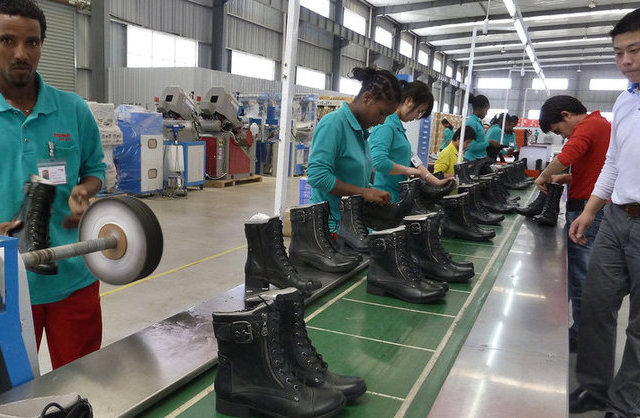 People working on the assembly line in April 2012 at Huajian shoe factory in Dukem, Ethiopia. (Getty)
People working on the assembly line in April 2012 at Huajian shoe factory in Dukem, Ethiopia. (Getty)
“Made in China” may be leaving your wardrobe.
As labor costs in the “world’s factory” continue to rise dramatically, global fashion brands are looking elsewhere to source apparel. In addition to established hubs like Bangladesh and Vietnam, the garment game is ripe for new players: Myanmar (Burma), Haiti and Ethiopia, among others, are looking to rejuvenate a once-thriving trade or even build one entirely from scratch.
China will shed approximately 85 million manufacturing jobs in the coming years, which some development experts say could be a golden opportunity for producing economic development, a la South Korea. The standard narrative: Start at the bottom with low-skill, basic textile manufacturing (like T-shirts) and work your way up to more complex garments (like suits), then to more complex goods like electronics.
Improved quality of life and a rising consumer class will naturally follow, creating sustainable and natural growth in China. At that point, garment assembly would be seen as lowbrow.
“You don’t make tanks out of textiles,” says Derek Scissors, a scholar at the American Enterprise Institute.
But whether China’s successors actually can follow the “textile to tank” model is a point of serious contention. Some argue that new entrants only can survive by offering the lowest costs — read: unlivable wages and minimal, if any, rights. Footloose garment brands — apt to flee to wherever labor costs are lowest — make nurturing textiles into an industry with highly skilled workers, robust infrastructure and effective regulation extremely difficult.
It’s harder to unlearn bad habits, so the best shot at a sustainable industry may be Ethiopia, which is essentially a blank slate. Despite dire infrastructure shortcomings, Ethiopia’s access to a continental market with six of the 10 fastest-growing economies and one of the world’s largest cattle (leather) stocks spurs “China 30 years ago” comparisons and makes the nation an attractive long-term investment.
The Chinese and Turkish certainly seem to think so. Huajian Shoes and Akya Tekstil, two of the world’s largest apparel-makers, are planning multibillion-dollar “apparel-cities” fit for up to 60,000 workers and 50 different manufacturers each.
Read more at NPR.org »
—
Join the conversation on Twitter and Facebook.

























